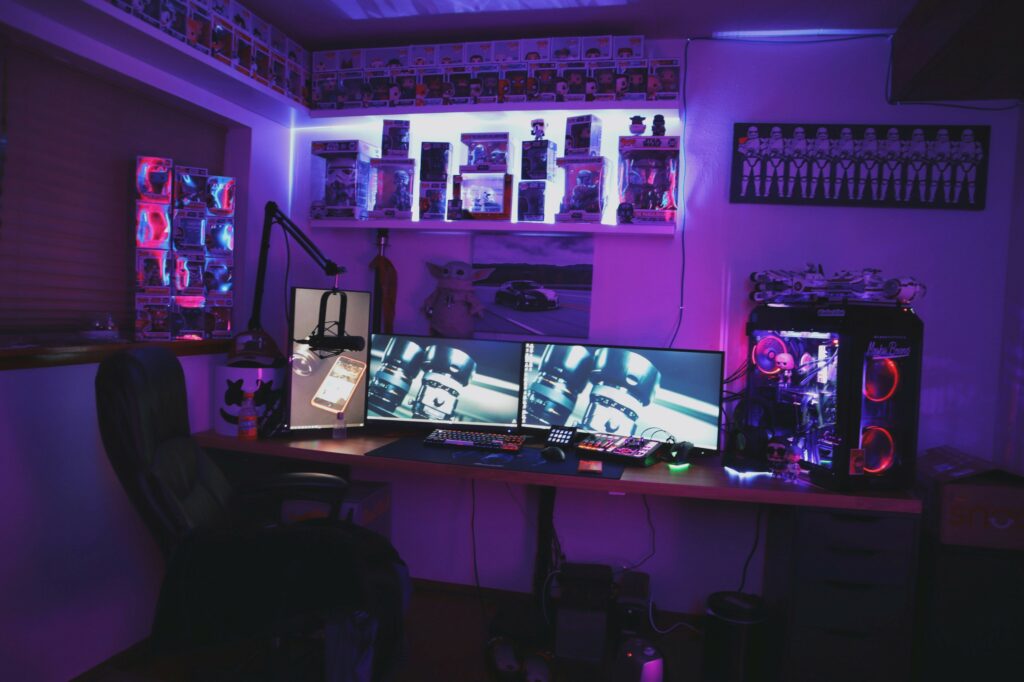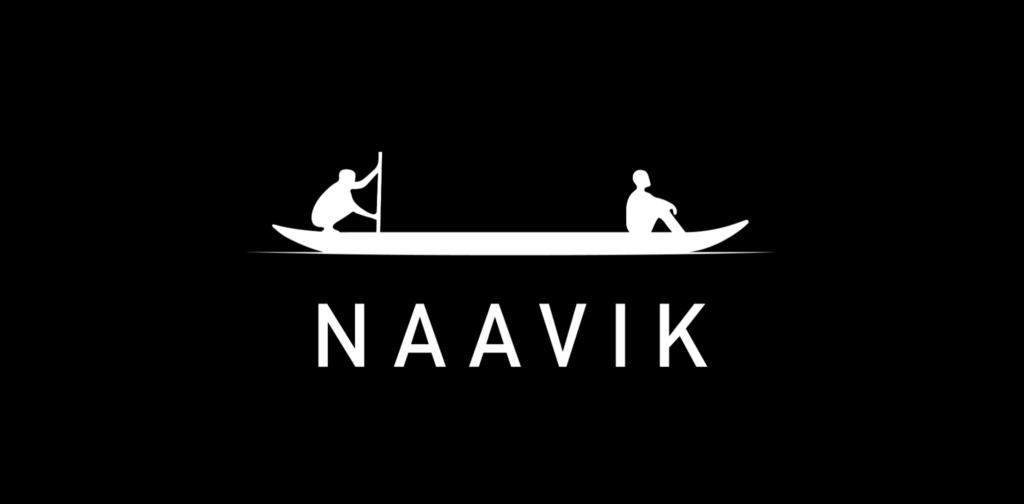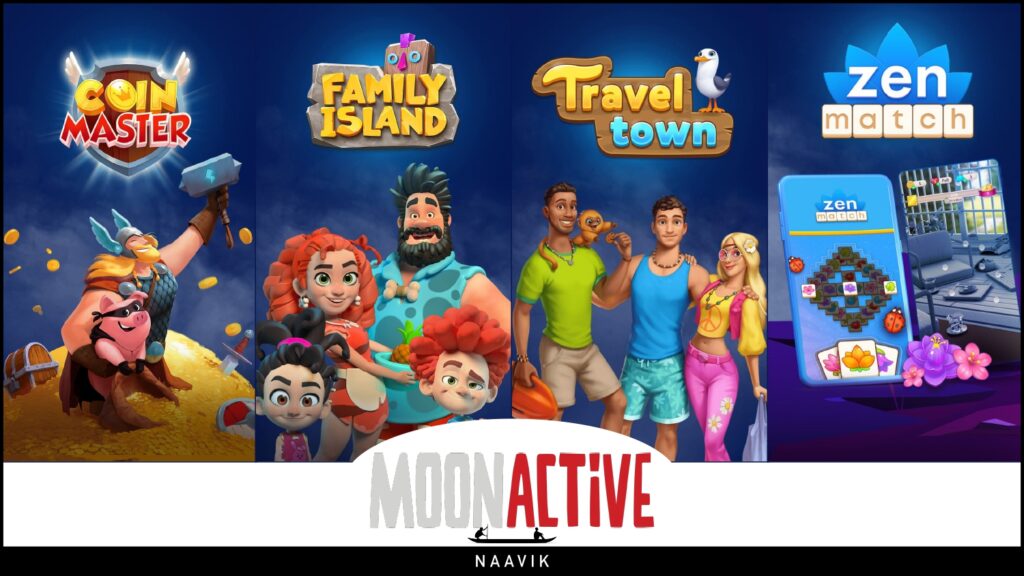
Rec Room is a free-to-play UGC game platform with cross-play from phones to VR headsets. Over the last six years, Rec Room has quietly become a top contender in the race to create the “metaverse”, amassing a total of 82 million lifetime users.
Rec Room hosted their developer conference last month, where they had several important updates:
- A new standalone PC client to accelerate user growth on PC.
- A new Rec Room Original game as a tentpole to keep players engaged.
- Most importantly, they announced an integration with Unity that is expected to enable creators to give games a whole new level of polish.
These announcements are familiar metaverse tactics that we’ve covered on Naavik previously. That is, great content attracts players, which attracts creators, who make more great content, assuming they have the right tools. However, Rec Room is particularly unique in that it was originally launched as a VR-first platform. As a result, the creator experience is immersive, highly collaborative, and in many ways, the main draw of Rec Room (as opposed to the content itself). I took a look at Rec Room’s impressive traction to-date, and chatted with its creator community to better understand the tools, economy, and what this means for the future of this leading metaverse company and potential acquisition target.
Rec Room Traction To-Date
Rec Room was founded by six former Microsoft Holo-Lens team members in 2016. Although there have been twists and turns, the company has taken off like a rocket: Rec Room’s latest fundraising round was a $145 million raise at a whopping $3.5 billion valuation. Having raised $100M earlier that year, the fast follow-on investment announcement was well-timed at the end of December 2021, just before the global economy went sour. Part of what justified such a valuation hike was that the company had gone from a reported 2 million lifetime players in March to 37 million by December (a 1750% increase in 9 months). Their most recent players number at RecCon, Rec Room’s annual developer event, was 82 million lifetime players.
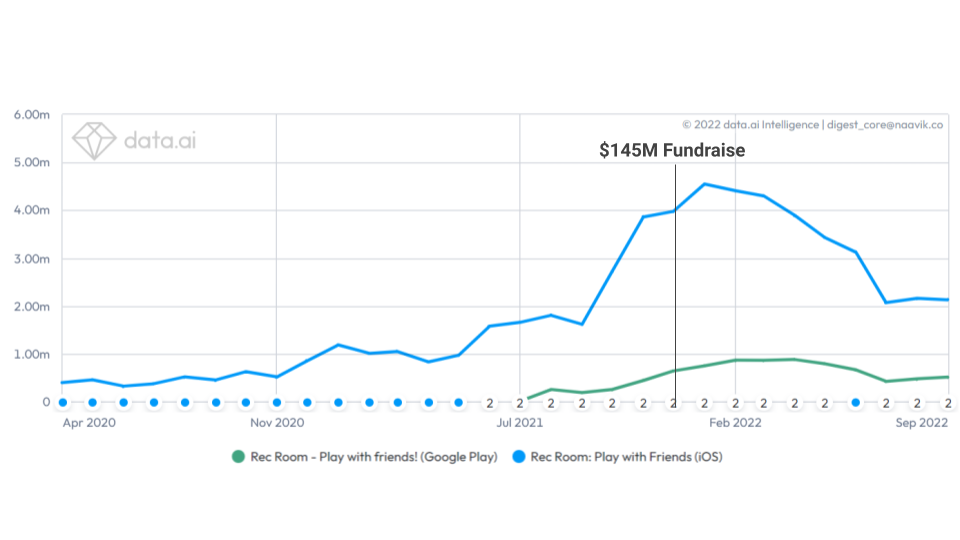
In addition to these mobile numbers, Rec Room reported 3 million monthly active users on VR back in April. Unfortunately, we don’t have the PC and console numbers to get the total user base, but a quick glance at the free-to-play section on the Playstation store has it just behind Rocket League and ahead of Apex Legends, two of the biggest free-to-play games in the world. These numbers demonstrate meaningful traction, especially for a platform that was originally built for the still nascent VR market. The numbers also reveal that Rec Room could not have picked a better time as their fundraise closed at the peak of their active users, before they dropped off considerably across much of 2022. This precipitous decline at a glance appears concerning, but it‘s important to remember that the core creator base is VR-focused so what appears to be difficulty retaining players on mobile, may not translate across all platforms. It’s also important to consider the context of that spike.
On October 28th, Facebook rebranded to Meta, unleashing a flurry of interest in “the metaverse”. Rec Room appears to have benefited majorly from all of the hype. But just like with Rec Room’s mobile users, interest in the “metaverse” concept waned albeit plateauing at a much higher level than before the rebrand. Furthermore, Rec Room likely benefited from holiday sales of the Oculus 2 as Rec Room sits right next to Beat Saber on Oculus Quest Store’s ‘Most Popular’ section.

Thus it would seem that the metaverse hype served as a year-long user acquisition boost, before normalizing back to Rec Room’s previous organic annual growth rate of 84% (see image below).
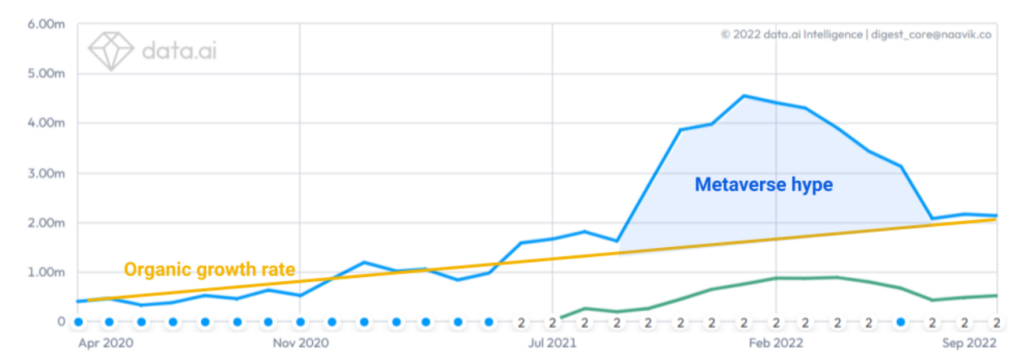
While Rec Room’s user growth has been strong, a key part of their long-term success will be determined by their ability to monetize to a degree that attracts more creators. Rec Room announced at Rec Con that they had paid out 5x more to creators this year compared to last year. Given their 2021 target of $1 million likely being surpassed, a reasonable estimate would suggest this payout to be above $5 million.
Let’s do some rough comparisons to other metaverse platforms I’ve covered:

**Roblox numbers are estimated by taking last reported MAUs and multiplying by reported growth rate in earnings call.
***Fortnite Creativeestimate assumes 50% of players play Fortnite Creative, though all weknow is it accounts for ~50% of playtime, not necessarily number of players.
****While I estimate that Fortnite Creative pays $125 million through Support-a-Creator code, the overwhelming majority of this goes to streamers as opposed to map builders. For example, the 100 Thieves Cash App Compound re-creation in Fortnite, the esports organization, 100 Thieves, made $500k, while the creators of the actual experience anecdotally made $15k.
Although Rec Room’s payouts per MAU are relatively low, they actually have the most favorable payout structure — taking only 30% of spend on UGC sales, compared to Roblox’s 70% take and Fortnite’s 95% take. This means that Rec Room is either making a substantial portion of revenue from first party content (their paintball game is the most popular ‘room’ on the platform), or they are under-monetizing.
Either way, a key to building a vibrant creator ecosystem is the ability for creators to make a living off their creations. I’ve previously covered how Roblox’s creator ecosystem has flourished to the point where venture-backed companies have entered the space, pushing the boundaries of what’s possible on the platform, whereas Fortnite Creative’s most successful creators have been held back by the low payout potential despite the platform's $5 billion annual monetization. With that said, Rec Room has been focused on creating an immersive and collaborative creator experience so let’s double click on creator experience as it stands today.
Rec Room’s Creator Economy
For simplicity, Rec Room creations can be bucketed into two primary categories:
- Inventions (power ups, items, cosmetics) — these are player-created objects with assigned functions.
- Rooms (i.e. games) — these are the experiences or games that are available for people to play. These rooms are landscapes with a combination of inventions that make up the gameplay.
Creators can monetize both Inventions and Rooms. Inventions are monetized by selling to other creators who want to include it in their Room. Rooms can then be monetized the traditional way by selling these inventions to players as part of their in-game monetization. For example, if I want to create the game ‘Super Sword Fighting’, I might purchase various inventions of swords, and put them in the item store in my game for players to purchase. I would make money off of the players who spend in my Room, and I would have to pay the inventors a one time fee for each invention in my room. If you’re wondering if making an in-game item is easy, the below screen grab is of a single medium-sized circuit, and an invention can be a single circuit or even a combination of several large circuits.
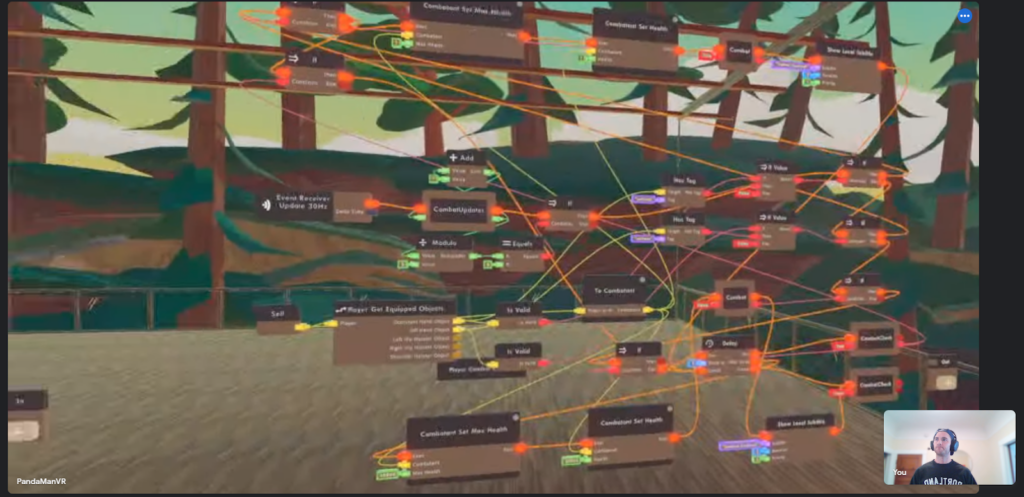
Traditionally with UGC platforms, lock-in comes at the cost of barriers to entry (such as needing to learn the coding language Lua to develop on Roblox). On Rec Room, the accessibility of the MakerPen, the drag-and-drop tool that a creator’s avatar uses to create objects and program logic, means that anyone can get started. But like any instrument, there’s also a learning curve: One circuit creator told me that it takes a couple of months before a new creator can make large circuits without the help of a friendly guide. This is an example of where Rec Room really shines. Anyone can get started, but there's an opportunity to steadily grow one’s skills with the help of others and create increasingly complex and functional inventions.
As you may have guessed, top creators informed me that their Rec Room income is still a ways away from being a full-time gig. One top creator said Rec Room income was almost enough to pay rent (certainly better than Manticore, but quite a ways away from Roblox). As a result, there is another primary way that creators are making money: they are creating experiences for off-platform companies–referred to as “commissions”.
A co-op whom I spoke with named Ink Overflow has come out as the leading organization for Rec Room talent and helps connect creators to companies or individuals looking to commission a new Room. I was told that many of Ink Overflow’s customers are looking to do VR demos and have apparently turned to Rec Room as the best way to show off VR’s capabilities. I have to say, after an interview with one creator in Rec Room, I became quite bullish myself.
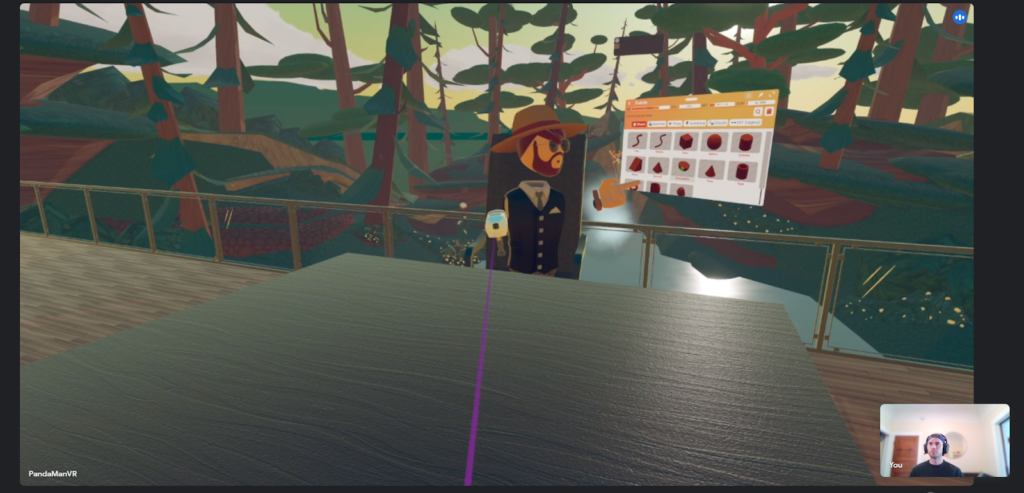
Rec Room integration with Unity
Just as Fortnite Creative integrates with Unreal Engine (expected to launch on December 4th), Rec Room is also planning an integration with Unity that should put more power in the hands of creators. Multiple creators reported that the creator community was anxious that their hard-earned MakerPen skills would now be obsolete. However, these same creators assured me that they perceived continued value in the existing toolset, especially as a collaboration tool and as a fast way to create and visualize objects in real-time and assign logic/behaviors to them. As far as the new capabilities that the Unity integration unlocks, it will make it possible to create and polish assets and environments in Blender or animate them in Maya and port them into Rec Room. In the end, we should expect to see much higher fidelity worlds–something that Roblox has also prioritized as a way to attract an older demographic who might otherwise play AAA games. While I am hopeful that the video prototype that Rec Room shared (image below) is a sign that they have made significant progress on the integration, the launch date has not been disclosed.
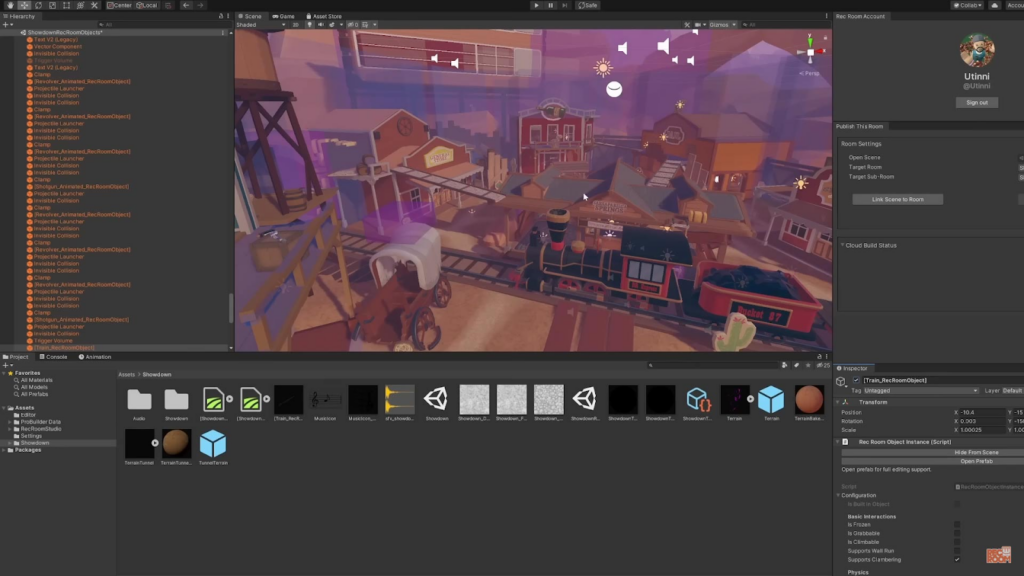
The impending launch of Fortnite Creative x UE5 will serve as a great case study for Rec Room on how a creator ecosystem responds to more technical tools. As one creator told me, "Prettier doesn't mean more fun." After all, nobody ever called Minecraft, the most downloaded game of all-time, pretty.
Rec Room As A Potential Acquisition Target
I believe that Rec Room’s strong creator suite and sizable user base would make them an attractive acquisition target for a company that is in need of a big-win in the VR space rather than necessarily an IPO candidate at the moment. Perhaps, a company that has a $10 billion annual war-chest to spend on launching the next internet platform and that has struggled to get traction and is under significant pressure now to demonstrate results. I believe that company is Meta.
Horizon Worlds, Meta’s flagship UGC platform, has 200k MAUs today, down from 300k in February and persistent bugs are a common reported experience on the platform. High profile articles about their struggles to create meaningful content undermine the larger vision of owning the platform of the future and inspiring a broader workforce to build towards that future. Meta’s 86% market share in the last quarter means that they are deeply invested in seeing the entire market grow. As we highlighted last week, Meta has been on a content acquisition tear as of late in an attempt to brute force VR growth. Rec Room is the second most popular game on the Oculus Quest Store after Beat Saber, which Meta acquired in 2019.
While Horizon Worlds targets adults and Rec Room’s demographic is much younger, Rec Room’s committed user base of an estimated ~10 million MAUs, VR-focused creator tools, and well established creator ecosystem could act as an important learning ground for the team at Meta who have struggled to get even their own employees to use the Horizon Worlds creation system. Furthermore, it won’t be too long before Rec Room players age out and are looking for the next platform to continue building on. After Rec Room’s last fundraise, our friend Joost Van Dreueren asked the question of Rec Room: “Will Zuckerberg buy or build?”
He tried to build it with Horizon Worlds, but now it might be time to buy.
What The Future Holds For Rec Room
Rec Room’s creation suite is compelling enough that creators are excited to build even if it remains a side gig in the short-term. The ~10 million MAUs suggest that this UGC platform is not just a flash in the pan. Furthermore, the integration with Unity on PC means that Rec Room may no longer be restricted to the middling growth of VR headsets as the best way to create. On the flip-side, Rec Room is still figuring out monetization with relatively low payouts per MAU. For a company that’s raised $294 million to-date, there is a lot of capital looking for a high rate of return. It's not hard to imagine the current revenue trajectory is worrisome for investors who invested when growth was looking exponential. We’ll keep a close eye on Rec Room, an impressive creator suite and community that could do wonders in the hands of a tech giant with big VR ambitions. (Written by David Taylor)
#2: Xsolla, X.LA, and Revenue-Sharing Smart Contracts
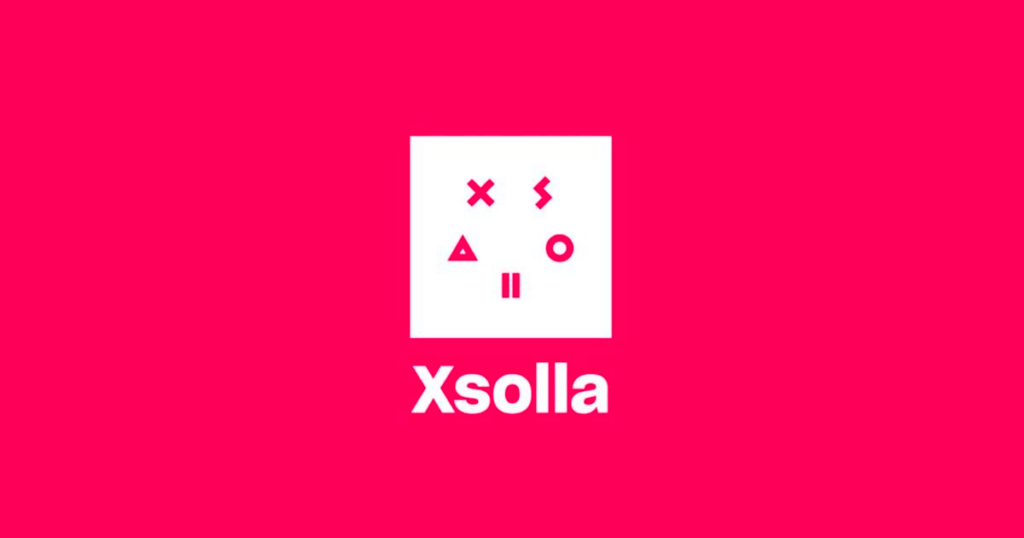
This is the introduction to a Research Essay that was written by Alex Summers and appeared in Naavik Pro. Be sure to request a demo to read the full write-up, and access our entire research library.
Xsolla is a massive player in the games industry, but you may have never heard of the company. That’s because Xsolla provides back-end payment services and operates behind the scenes in its customers’ games. It provides a “Transaction Engine” and a “Business Engine” to help developers and publishers market, sell, connect, and optimize their games globally. Xsolla has been helping game developers across the world for over 15 years, and among its customers are major gaming establishments like Valve, Twitch, Epic Games, Roblox, Krafton, Ubisoft, and miHOYO.
Given Xsolla’s global reach, integration with leading gaming franchises, and the nature of its products (payment integration), it is uniquely positioned to facilitate the adoption of blockchain elements in games. Further, its founder and former CEO started a new web3-focused initiative in February 2022, X.LA, which is a decentralized protocol that allows content creators to leverage their IP so that they can profitably participate in the metaverse economy by utilizing revenue-sharing smart contracts.

To learn more about Xsolla and X.LA, we interviewed founder Alexander “Shurick” Agapitov. This conversation is exclusive to Naavik Pro, and we’ve included key snippets (lightly edited for clarity) throughout this essay.
Founded in 2005 by Shurick Agapitov, Xsolla’s platform (formerly 2Pay) tied in local payment methods like cash kiosks, prepaid cards, and money orders to help games monetize audiences in countries where typical credit cards were less common. Xsolla was a market leader in the internet banking services that arose in the early 2000s, and since the company’s inception it has been focused on the games industry. Today, Xsolla provides a full suite of monetization and live operations products and services to game developers and publishers. The company, headquartered in Sherman Oaks, California, operates in more than 200 countries and over 20 languages, and it has more that 450 employees. Its gaming business engine helps game developers and publishers operate more efficiently and provides the infrastructure for microtransactions and related security/compliance. Xsolla caters to its customers, which range from indie to enterprise, with solutions that solve the complexities around in-game monetization.
Founder Shurick Agapitov describes Xsolla as “Shopify for video games” and credits its revenue-sharing model for much of the company’s success. In 2020, Xsolla reportedly recorded a revenue of $67M (with 75% YoY growth) and EBITDA of $33M (50% YoY growth). In April 2022, Bloomberg reported that the private company could be worth as much as $3B on the public markets — a higher valuation than companies like Netmarble and CD Projekt.
But how does XSolla help Game companies, and what are it’s plans for the future with such aggressive revenue and growth? Let’s dive in.
Content Worth Consuming
How the Creator Economy is Diversifying Gaming (SXSW): “The creator economy is diversifying power, influence, and opportunities within the gaming industry. Thanks to new platforms and technologies, communities that have been traditionally marginalized in gaming are finding their voices. This diverse panel will discuss ways in which the creator economy is achieving this: from new safe and welcoming spaces to publish gaming content, to booming adoption of gaming in emerging markets, equity-free VC alternatives for smaller games developers, and the rise of micro-influencers with niche, more dedicated follower bases. It is only thanks to technology that even more people from diverse backgrounds can make a living off their gaming hobbies.” Link
On Game Creation and Founding A New Studio (EGD): “In today’s episode, I’m interviewing a friend of mine, my ex-colleague Touko Tahkokallio, who was the designer on games like Hay Day, and Boom Beach and led the Brawl Stars team at Supercell. And he’s now doing his own studio in Helsinki with a group of experienced game developers. In this discussion with Touko, we discuss his learnings from creating both board games and video games and how he sees teams or pairs of excellent individuals working together to create these games.” Link
Bringing Match-3 Back to Life (Udonis): “Project Makeover was released in November 2020 by Bubblegum Games (under Magic Tavern). It has been just a few months since the release and the game is already crazy successful. It went from zero to millions of dollars in the blink of an eye. Project Makeover had an explosive release and a subsequent couple of months, where downloads reached an all-time high. However, after January 2021, the downloads have been on a steady decline. This goes to show how hard it is to keep a casual game relevant in this market.“ Link
🔥Featured Jobs
- Legendary Play: Senior System & Economy Designer (Remote)
- Bungie: Director of Product Management (Remote — US)
- Guerrilla Games: Technical Animation Manager (Amsterdam, Netherlands)
- Manticore: Head of HR and Recruiting (Remote)
- Naavik: Content Contributor (Remote)
- Naavik: Games Industry Consultant (Remote)



